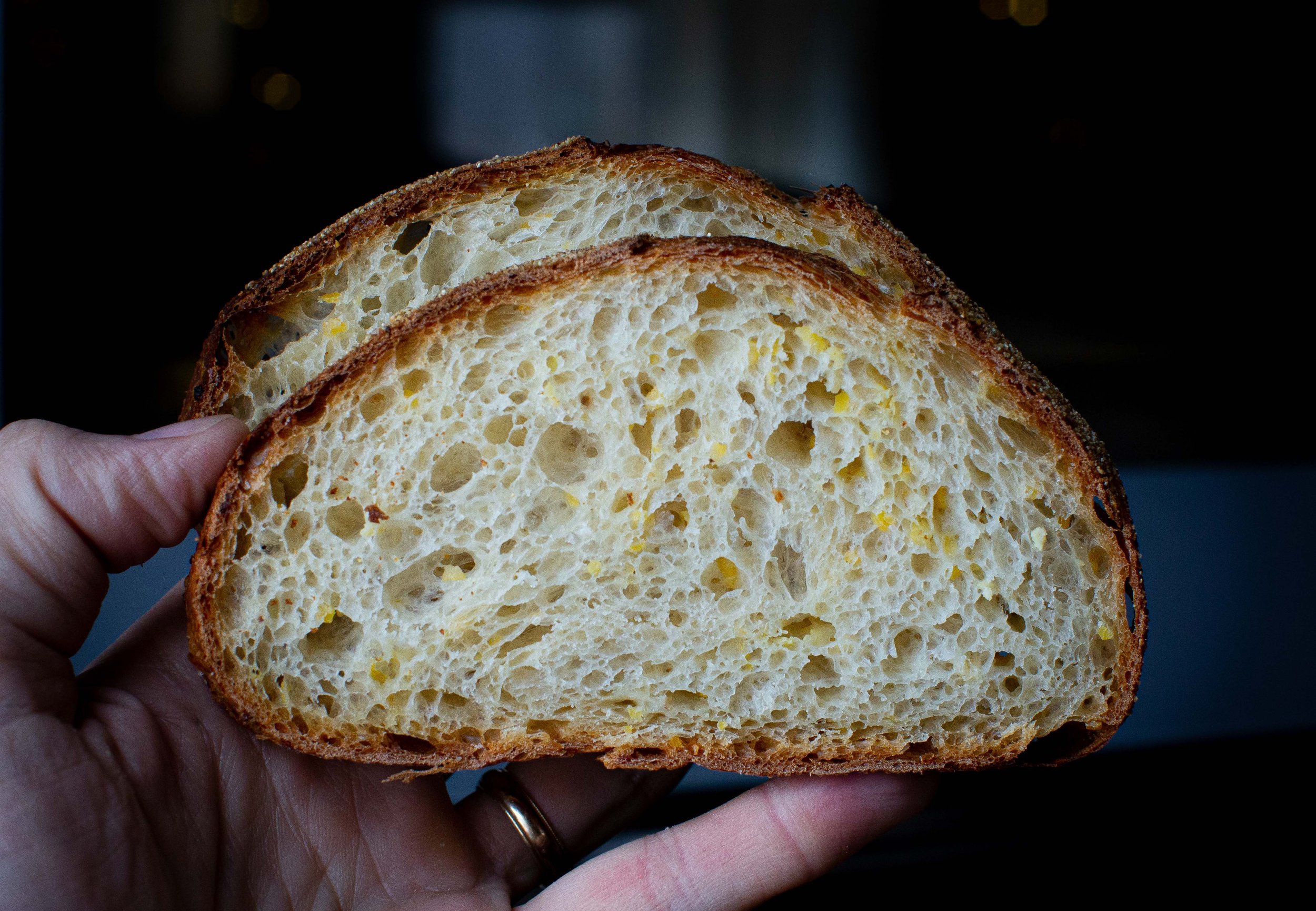Lemon Cracked Corn
lemon cracked corn
This bread has seen a dozen iterations in the past week. What began as a cracked corn ciabatta made with blue corn grits, blue corn flour, and smoked salt on the crust, has become something completely different. While the original was interesting, I think this is better.
For the iterations, I started with chunks of cooked grits and lemon zest in a very slack dough (delicious, but limited applications), then went to a high hydration shaped loaf (too much trouble to get the grits in), to low hydration loaves (too dense, poor keeping quality), to breads with preferments (great but I wanted a shorter timeframe), and breads made by rolling the grits up inside (structure wasn’t as nice as I wanted), before finally settling on a light lift method that produces a truly exceptional loaf in an afternoon.
The result has been eaten as toast, french toast, grilled cheese, and more. Anthem says it’s her “Number one toast bread, ever.” The crisp crust with the aroma of lemon and texture of grits allows it to bend towards both savory and sweet. The crumb is not that open—it will hold fillings very well while not being terribly dense. It is delicious. Let’s get to the recipe.
For the baker’s math folks, click the link below for the spreadsheet.
Prepare the grits
Cracked corn grits, 75g (1/2 cup) (Consider a source such as Marsh Hen Mill)
Water, 225g (1 cup)
Salt, 2g (1/2 t)
Butter, salted or unsalted, 15g (1 T)
Combine everything in a small pot and bring to a boil, stirring constantly. Cook until the mixture is the consistency of thick pudding or oatmeal — four to five minutes. Pour the finished grits onto a plate to cool while gathering the remaining ingredients. Note that this amount is a little more than what’s required for the recipe. Measure what your yield is after cooking and enjoy the small extra amount as a baker’s treat.
Mix the dough
Water, lukewarm (85 to 95F), 254g (1 1/8 cups)
Buttermilk, lukewarm, (85 to 95F), 224g (1 cup)
Salt, 15g (2 1/2 t)
Honey, 18g (1 T)
Yeast, dry, instant, 4.5g (1 1/2 t)
All-purpose flour, 597g (5 cups)
In a large mixing bowl or 6 QT Cambro, stir together the water, buttermilk, salt, honey, and yeast. Add the flour and mix to combine then knead briefly in the container with a wet hand, pressing and folding until the dough is roughly homogenous. At the end of mixing the dough should feel supple and slightly sticky. If it feels firm, add a little additional water, one tablespoon at a time, until it softens some. Cover and rest for 30 minutes. (See the sample dough schedule, below, for reference.)
Lemon zest, 10g (2 T) (two large lemons)
Grits, 179g (3/4 cup)
Add the cooked grits and lemon zest to the dough, pressing them in with fingertips, squeezing and folding to combine. The mixture will be a mess; the dough will break apart and you’ll wonder if it will ever come back together. It will in the subsequent folds. Cover and rest for 30 minutes.
Fold
Give the dough a bowl fold, folding from the outside to the center 8 to 12 times, working your way around the bowl. Then cover and rest for an additional 30 minutes. After the second period of rest, repeat the bowl fold. (Again, see below for a sample schedule.)
Shape
Preshape:
On a lightly-floured surface divide the dough into two equal pieces, roughly 650g each.
Gently preshape as rounds.
Place on a lightly-floured surface, seam-side-down. Cover and rest for 15 minutes.
Final shape:
Gently shape the loaves as bâtards (rounds are fine, too!), then roll across a moist towel and through cornmeal, thoroughly coating what will become the top of the loaf.
Place in lightly-floured bannetons, cover, and proof for 60 to 75 minutes. At the end of proof the loaf should feel spongy, marshmallowy, and only slowly fill the impression left by the gentle pressure of a finger. During the final proof preheat the oven and baking stone or steel (or covered bakers such as challenger breads pans) to 450F. Also preheat your steaming device (cast iron pan or old cake pan filled with lava rocks).
Bake
Score the loaves as desired and bake with steam for 15 to 20 minutes then reduce the oven to 425F and bake for an additional 20 to 25 minutes or until the loaf is deeply colored (see the picture, above). As the loaf has a little honey in it, check the bottom crust after the initial 15 minute period and also at some point after reducing the oven to ensure that it’s not taking too much color. If so, place the loaves on a sheet tray to finish baking.
After the total bake time of 35 to 40 minutes, turn the oven off and let the loaves coast for an additional 10 to 15 minutes with the door open a few inches. This will help to set the crust.
Cool and enjoy!
Sample schedule:
Here’s a sample schedule in the event it helps to plan a dough day. Note that bread timings are usually rigid only for the purpose of writing them in a way that’s easily quantified. If folds are 45 minutes apart or, if the total time between mix and divide is three hours, don’t sweat it. It’s ok. Generally, timings before the divide are pretty loose. After shaping, the dough will likely need 60 to 75 minutes to rise unless you cover and place in the refrigerator to extend the time between shaping and baking.
Mix: 9:00 am
Add grits and zest: 9:30 am
Bowl fold: 10:00
Bowl fold: 10:30
Divide and preshape: 11:30
Shape: 11:45
Bake: 12:45 - 1:15



